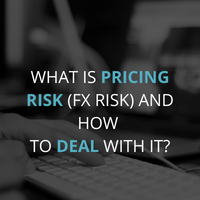What is Pricing Risk (FX Risk) and how to deal with it?
22-09-2022 | Harry Mills | treasuryXL | LinkedIn
Also known as pre-transaction risk, pricing risk occurs between a transaction being priced and agreed upon. It materialises when exchange rates change after a quote has been delivered, either impacting the sales margin or incurring a re-price. treasuryXL expert Harry Mills, founder & CEO of CEO Oku Markets, will explain to us what Pricing Risk is all about, and how to deal with it.
By Harry Mills

Who experiences pricing risk?
Businesses experience pricing risk to a greater or lesser extent depending on the nature of their business, their marketplace, and their sales and purchasing cycles. We find it helpful to consider the following initial points when assessing pricing risk:
- Is the transaction FX-denominated, influenced, or relatively insensitive?
- What is the timeline between quoting and agreement?
- What impact would a +/- 5% or 10% FX move have on margins?
A transaction is “FX-denominated” when it is in a currency other than the firm’s functional currency. An example is a UK business providing a quote to an Irish business for an export sale denominated in euros (instead of GBP).
How much influence? An example…
You’ll likely have an intuitive idea of the level of influence that fluctuations in FX rates have on your transactions, but consider a UK company that designs and builds high-end bespoke summer houses (why not?):
- The company imports unfinished timber and metal fixings priced in dollars, and sources glass and other furnishings and materials from within the UK
- The per-unit cost of production will be affected by movements in the GBPUSD exchange rate because timber is a major cost
- But the basket of production costs also includes the UK-sourced materials, shipping, labour (design and build), amongst others (warehousing, storage etc.)
- So we can see that a 5% drop in GBPUSD wouldn’t result in a 5% increase in production costs – understanding this relationship and ratio is critical
“Businesses should understand the precise impact of currency fluctuations on their costs and/or revenues to determine their FX sensitivity, especially concerning pricing risk”
Harry Mills, Founder & CEO Oku Markets
One-Size doesn’t fit all
Getting to grips with pricing risk can be fairly straightforward for FX-denominated transactions with a straight-through and linear FX impact on the price, but most businesses have a more complex setup.
Many businesses are converting from a just-in-time to a just-in-case stock strategy. which can bring complexity and may add to pricing risk. It’s our view, here at Oku Markets, that there is no one-size-fits-all approach for currency management, so here’s a few areas to think about:
- Stock cycle and costing method
- Pricing strategy and flexibility
- FX price sensitivity (as detailed above)
- The competitive environment and market practices
Pricing risk can impact procurement and sales, although we mostly think about the pricing that we are delivering. What about the pricing we receive, as customers? It’s not uncommon for Chinese exporters to add a large buffer to their prices to factor in fluctuations and depreciation in the USDCNY exchange rate. Read more about China and the yuan.
So it’s worth considering and asking your suppliers and international partners about how they manage FX – is there an opportunity for increased transparency and better terms by tackling the problem together?
FX Risk Map
It might be helpful to visualise the lifecycle of a transaction to identify when currency risk occurs. Again, there is no one-size template for this – every business’ FX Risk Map will look a little different, but here’s a basic setup to get started with:
- Pricing Risk: the FX risk between quote and agreement
- Transaction Risk: the FX risk between agreement and settlement
- Translation Risk: the FX risk between accounting (PO/invoice) and settlement

Dealing with Pricing Risk
Three ways you can reduce pricing risk and deliver more consistent results are:
- Include a quote expiry date – limiting the time reduces risk
- Add an FX buffer to the price – 5% is typical for short periods
- Build an FX clause into the quote – transparency means no surprises
The most appropriate route or combination of mitigating actions is unique to each business. An online travel company delivering live holiday prices will require higher frequency updates to FX rates and a tighter quote expiry date and FX buffer when compared to a company providing quotes for custom-designed summer houses.
When it comes to an FX buffer, we suggest considering the volatility of the currency pair and adjusting for the relevant quote period.
Let us help you quantify your FX risk
Quantifying currency exposure requires thought and specialist skills and expertise. Most FX brokers lack the capabilities to do this properly, resorting instead to emotionally-charged deal-making which can result in poor outcomes for clients.
We’re proud to work transparently with our clients, and we work hard to break the asymmetry of knowledge and information in the FX market.
You can contact us for a review of your currency processes and for our guidance and suggestions at [email protected] or 0203 838 0250.
Thanks for reading 👋

Harry Mills, Founder at Oku Markets



